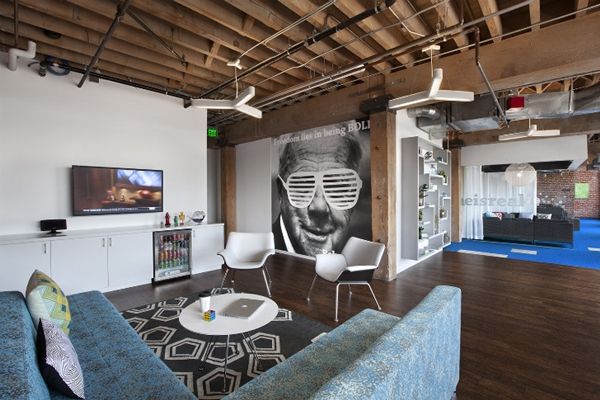
The evolution of existing ideas combined with advances in modern technology are creating a more humane experience of work, as Angela Ferguson writes

The evolution of existing ideas combined with advances in modern technology are creating a more humane experience of work, as Angela Ferguson writes
In the modern world, the consumer is more powerful than ever and the desire for personalisation is driving an increasingly flexible and bespoke market. This applies to all products and services we consume, and is fast becoming an important factor in the success of design.
Designers need to consider how their products can give the end user the autonomy and flexibility they desire, whilst at the same time demonstrating creativity and innovation.
At the 2017 Salone del Mobile Milano (commonly known as the Milan Furniture Fair) this was nowhere more prevalent than at Workplace 3.0; a section of the Fair perhaps not as celebrated as others, but just as influential in its demonstration of where the future of design is heading as it relates to the spaces we work in.
There were three main trends in workplace design at the Milan Fair this year. These were mostly evolutions of existing ideas, combining advances in modern technology with a desire to create a more humane experience of work.
The common thread in all of these trends is the emphasis on people at the centre of all design.
1. The Smart Workplace
The Internet of Things (the internetworking of physical devices embedded with software in order to collect data and improve experience) is increasingly being extended to more and more elements of the workplace.
At the fair this year, Tecno showcased walls, desks and screens that included integration of technology with desks, tables and walls. They have branded this the io.T or ‘Intelligence of Tecno’. This is an exciting development in workplace design; Tecno have created desks, walls and tables that are no longer dumb, inanimate objects. These physical, analogue items now talk to each other and to the user to create an experience that is about improved wellbeing of the individual, allowing personalisation, efficiency, a focus on health and mass customisation of shared settings.
Io.T animates the workplace to make it more human, more welcoming and diverse, accommodating an endless range of preferences, workstyles and personalities.
2. The Adaptive Workplace
The Milan Fair 2017 emphasised the evolution of the office to one ‘adaptive’ space, rather than a fixed menu of spaces that have only one purpose. No longer is the workplace ‘set in stone’ rather it is something that can be fluid and flexible, controlled by the user’s taste and requirements. One example of this was the CHRONOTOPIC System (or Magic Cube) Designed by Architect Alfonso Femia from Italian architecture practice 5+1AA. The Chronotopic system is a DIY, reconfigurable series of cells that can be infinitely changed by the user, creating privacy or collaboration as required.
Also tapping into the easily adjusted and modified workplace trend was Bene’s new PIXEL system. Pixel is a series of 36cm plywood cubes that define the office as a ‘living space’ constantly needing to adapt and alter as the workplace evolves over the course of the day. Specifically aimed at a new (startup) audience, Pixel recognises that the workplace is no longer just the realm of the large corporates; the system is designed to inspire creative thinking, innovation and new ideas. Pixel is based on the premise that a different type of environment will promote a different type of thinking and therefore, innovation.
3. The Biophilic Workplace
Biophilia is about a love of the natural world and the affinity that human beings have with nature. For many years across the globe we’ve been designing sustainable workplaces. Recently this has evolved into workplaces that have a focus on health and wellbeing. Now this is evolving further into the biophilic workplace; an environment that not only includes nature but that is also based on the perfect balance that can be found in nature and people’s connection with this balance.
At the Milan Fair in 2017 Humanscale showcased two new products that align with the conditions and behaviours found in nature. The first is the Trea chair whose design references a lobster’s shell and mimics the natural recline of the human spine. The second is the Vessel light, a glare free cylindrical light with a concealed LED source that connects biological lighting and wellbeing. Based on Humanscale’s values of simplicity and function, these products have been designed with the Golden Section (the mathematical equation upon which all elements in nature are created) in mind and are part of a bigger story about our humanity and the role nature plays in this.
Workplace 3.0 at Salone del Mobile Milano 2017 aimed to redefine the idea of work as ‘labour’ and instead attempted to position work, and the workplace, as an environment that is nurturing, intellectually creative and a joyful place to be. For too long workplace design has been treated primarily functional, producing products and spaces devoted to productivity and devoid of engagement.
The prevailing trends this year were about creating a vibrant, energetic, evolutionary workplace of the future; a place where a diverse range of humans can all be autonomous and create the environment they need in order to thrive.
About the author
Angela Ferguson is the MD of Futurespace. Futurespace is a cutting edge interior design and architectural agency leading the way in creating the future spaces in which people will work, learn and live. Futurespace designs and creates future focused, intelligent and practical physical spaces that enhance people’s lives and businesses. www.futurespace.com.au